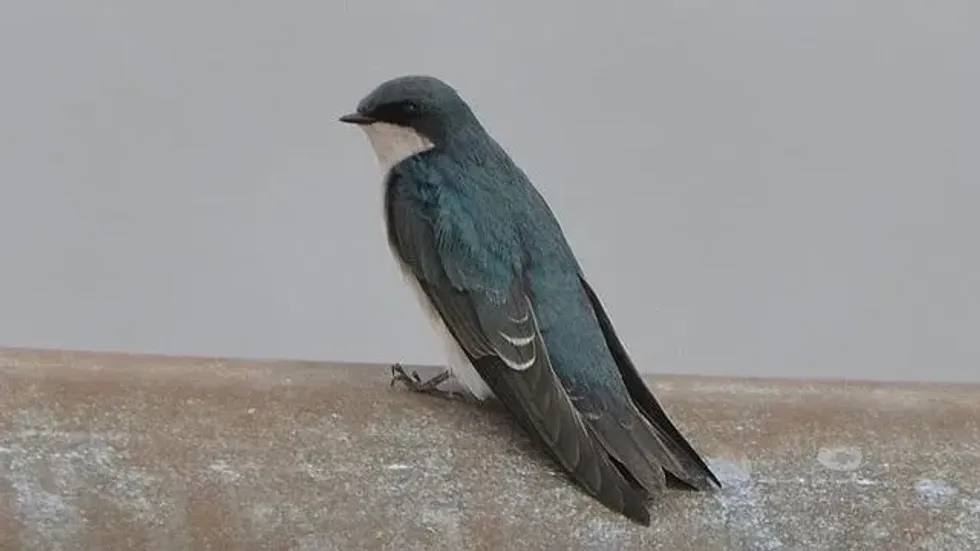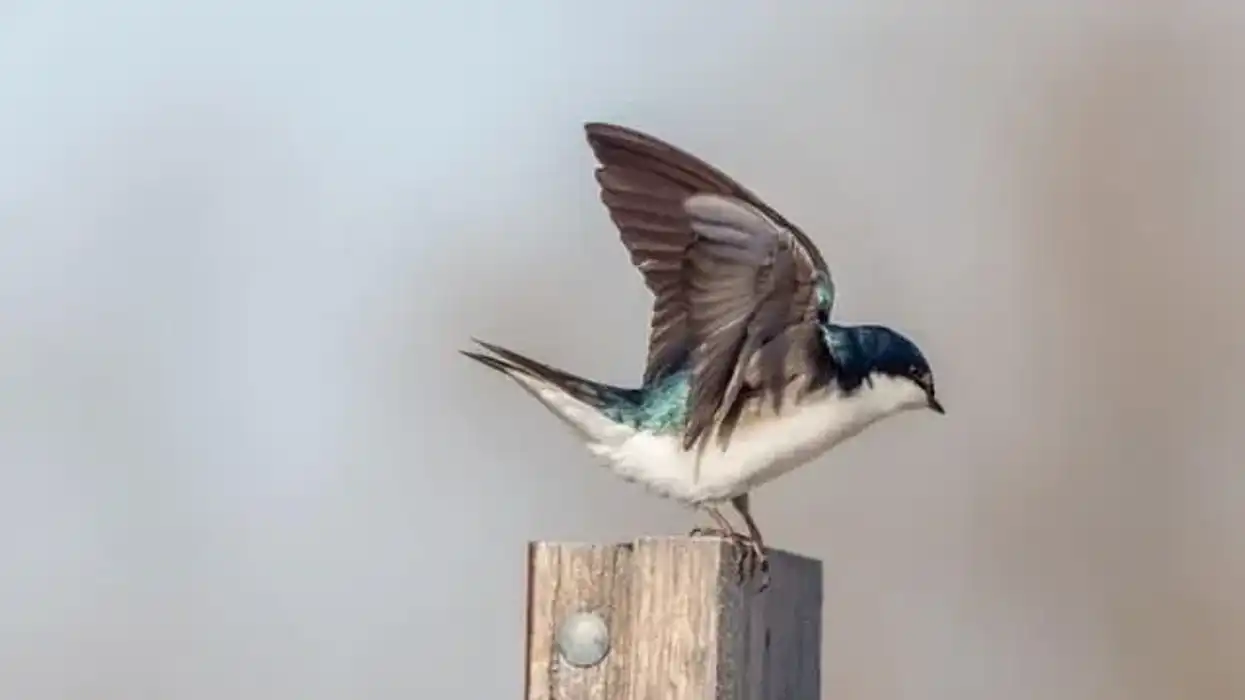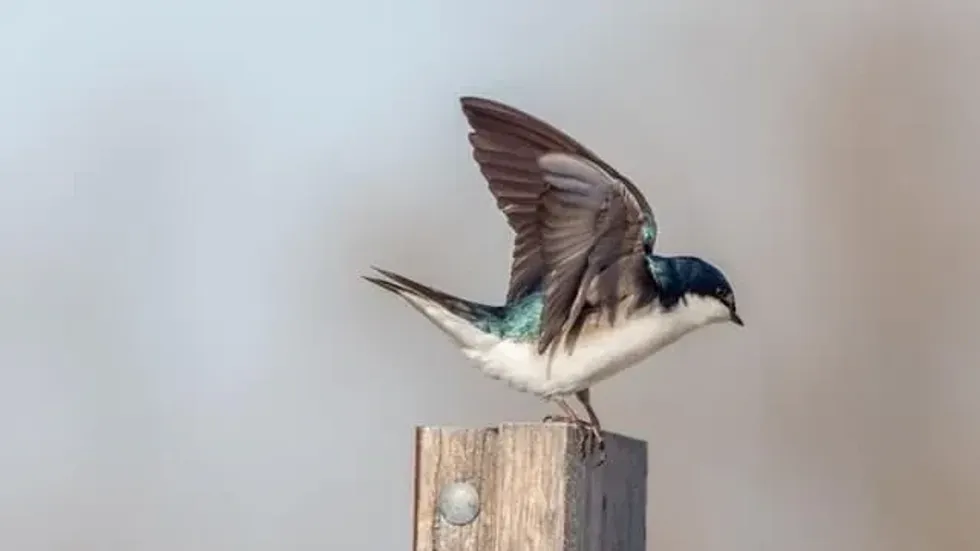Fun Golden Swallow Facts For Kids

Are you planning for a birding session in the mountains of the Dominican Republic? Then, don't forget to include the golden swallows on your birds' list to watch. When birds flock to the open meadows to feed, it's not uncommon for people to spend hours observing them.
The species name is available in all types of language. As for the name of these species of swallows, there is still debate whether its color matches its English name (golden) or its Spanish language name (Verde, which means green).
Let's get your doubt clear before you continue reading the article. As the golden swallows fly, the color you see on the upper parts of the body keeps on changing and reflects differently due to the rays of sunlight.
You might see a bluish shine to golden shimmering color; then it changes to olive green. These swallow birds are sure to captivate your attention as you bird watch them.
If you are a bird lover and want to know more about this enthralling bird species, read further to know more. Furthermore, enhance your knowledge with our house wren fun facts and Magpie surprising facts.
Golden Swallow Interesting Facts
What type of animal is a golden swallow?
Swallows are fascinating and graceful birds who not so common backyard visitors. Because of this reason, it is quite challenging to attract swallows, even for the experienced birders with many feathered guests.
Golden swallow (Tachycineta euchrysea) birds are diurnal. They search for their food at dawn, increasing activity in the morning and decreasing before the afternoon.
They go in search of food in every kind of habitat except the forest. The golden swallow birds are known as aerial insectivores. They fly down to the ground to catch their prey alone or in groups.
Also, golden swallow birds are secondary cavity nesters, which means that they live in the nest built by others. So, you can look for them in the old woodpecker nests and in the rocky cliffs with small crevices. Like many other birds, the golden swallow (Tachycineta euchrysea) birds also use artificial nests built of boxes.
What class of animal does a golden swallow belong to?
The golden swallow (Tachycineta euchrysea) belongs to the class- Aves and the family- Hirundinidae.
How many golden swallows are there in the world?
The population of the golden swallow (Tachycineta euchrysea) birds is expected to be around 1500 - 7000 within an area of 5033 mi (8100 km).
The Tachycineta euchrysea bird species are found in small numbers, fragmented, and declining; consequently, it is considered Vulnerable. From the 19th century, the golden swallows are found to be declining. But the decrease in their number has been controlled because of its rarity.
Where does a golden swallow live?
The golden swallow lives in the woods and forests. Mainly found in the isolated montane forests that consist of the Hispaniolan pine tree.
The Tachycineta euchrysea bird species is a swallow native to the Caribbean Islands of Hispaniola (divided between the Dominican Republic and Haiti) and once in Jamaica, but now it has been suppressed there.
What is a golden swallow's habitat?
The golden swallow is indigenous to the Caribbean Islands of Hispaniola. This species was once found in Jamaica, but now it has been extirpated.
It resided in altitudes of up to a height of 2000 m (6600 ft) from the sea level in Jamaica. Currently, the golden swallows reside at the height of 800 m (2600 ft) on the island of Hispaniola. When not breeding, these swallows usually move down to the lower altitudes.
The distribution range of the golden swallows is around 8100 km2 (3100 sq mi). It mainly occupies the hills of the interior parts of the islands.
It prefers the open country, but you can sometimes see them occasionally in the forests and nearby towns. Golden swallows primarily restrict themselves to the montane forests that consist of the Hispaniolan pine trees.
Who do golden swallows live with?
The golden swallow lives alone or in groups.
How long does a golden swallow live?
The golden swallows live for three years.
How do they reproduce?
The golden swallow birds usually build a cup-shaped nest in the holes of the Hispaniolan pine created by the Hispaniolan woodpeckers.
The golden swallow birds also nest in the caves or under the roofs of the houses. The nests are build of fine vegetable fibers like cotton, pappus, silk, and feathers.
The breeding season takes place between June to July in Jamaica and between April to July in Hispaniola. During the breeding season, the golden swallow birds nest in pairs and lives in a colony.
They are known to lay two to four white eggs with tiny spots on them. Females lay one egg each day, sometimes a gap in between. Females are responsible for incubating the eggs. The incubation of the eggs lasts for 17-20 days. The chicks start learning when they are 24-27 days old after the hatch.
What is their conservation status?
According to IUCN, the conservation status of the golden swallow (Tachycineta euchrysea) bird species is Vulnerable.
Golden Swallow Fun Facts
What does a golden swallow look like?
Golden swallow birds are known to measure around 4.7 in (12 cm). These little birds weigh only 0.458 oz (13 g). The upper parts, including the head, chin, and chin, are shimmery bronze.
The holes and corners of the ear are dull. The crown, nape, and forehead are green. The back, rump, upper tail, mantle, and shoulders are golden or coppery-bronze. The lesser and medium parts of the wings are golden, while the greater and the primary wings are green and dusky.
The tail of the Golden swallow birds is slightly v-shaped or divided. The underparts are white with golden stripes on the sides. The legs and feet are a darker shade of brown, and the beak is black.
The appearance of females is similar to that of males. But the underparts, throat, breast, and under tail are speckled greyish-brown in females; as the females become more mature, the speckle around the breast and the neck decreases with time.
The young ones, like the females, have speckled greyish-brown. The young ones' feathers are also less shining, and the sides of the head are dull grey.
It's amazing to watch them twist and turn their wings as they dive through the air with elegance and accuracy as they hunt for the airborne insects, their primary food source.

*Please note that the above image is of a tree swallow, a similar image of the golden swallow. If you have an image of a golden swallow, let us know at hello@kidadl.com
How cute are they?
The golden swallow (Tachycineta euchrysea) bird species are one of the cutest and rarest bird species. It is one of the most beautiful bird species in the Hirundinidae family, which is native to the Caribbean Islands.
The upperparts and sides of the head are somewhat bronze or golden. The back, shoulders, mantle, rump, and upper tail are coppery-bronze or golden. The forehead is green.
How do they communicate?
The golden swallow (Tachycineta euchrysea) bird species are loud, but they make a soft call. It is a two-note call, described as a tchee-weet that is continuously repeated.
Swallows are known to produce different types of calls or songs. These calls are used to express their excitement while communicating with each other of the same species. Also, these calls are made during coupling or to alert each other in case of a sudden predator approach.
An interesting fact is that the songs of the male golden swallow birds are related to their body condition. The female golden swallow birds probably judge them to know the physical condition of the males and how suitable they are for mating.
The begging calls are made by juveniles when seeking food from their parents. The juvenile call or song of the golden swallow birds is simple and sometimes with a musical twittering.
How big is a golden swallow?
The golden swallow bird species is around 4.7 in (12 cm) long.
Thus, golden swallow birds are four times bigger than the golden-crowned sparrow.
How fast can a golden swallow fly?
The golden swallow birds usually fly fast when it comes to catching insects for food. It flies at a height between 20 m (66 ft) and 30 m (98 ft). Black swifts are known to fly at the height of 20 m (66 ft) and are often found flying near the golden swallow birds.
How much does a golden swallow weigh?
The weight of golden swallow birds is around 0.458 oz (13 g). Therefore, their weight is less than purple martins.
What are the male and female names of the species?
Female species are called female golden swallows, and male species are called male golden swallows.
What would you call a baby golden swallow?
A young golden swallow is known as a chick.
What do they eat?
Golden swallow birds are aerial insectivorous. They feed on true bugs, flies, and other insects.
They are often found at a height between 20 m (66 ft) and 30 m (98 ft) to catch their prey. The golden swallow birds come lower to the ground, usually to catch their prey. They go in search of food in the early morning hours and are back home during the afternoon.
Are they poisonous?
No, the golden swallow birds are not poisonous.
Would they make a good pet?
Yes, the golden swallow birds would make a good pet. Humans accept swallows as they are insect eaters and helpful for the environment.
Some of these bird species have even built nests around human habitation. Barn swallow birds and the house martin are now found near human habitats. Even the purple martin is active near humans and lives on the nests built of boxes.
Did you know...
The term swallow is used unofficially in Europe as an antonym for the barn swallow species. Under Hirundinidae, around 90 species are known and are divided into 19 genera. A great diversity of swallow species is found in Africa, where they have expanded themselves as hole nesters.
The swallow bird species are also found inhabiting the volcanic islands. Most of the swallow bird species in Europe and North America migrate long distances. But the swallow bird species in West and South Africa are non-migratory.
Wild forces beyond human control rule the sea. So to see swallow bird species at sea is considered a good omen by sailing voyagers in the past. They are considered good luck probably because the swallow birds are land-based species, so their appearance motivates the sailors that they are about to approach land.
The swallow bird species are protected by the Migratory Bird Treaty Act of 1918. So, it is illegal o capture the swallow bird species or kill them or destroy their nests and eggs.
Some swallow bird species migrate to the warmer regions during the winter months. However, according to a news source, thousands of swallow bird species died in Greece while crossing Africa to Europe during the spring season.
The reason could be that a combination of cold weather conditions, strong winds, and few insects to feed on may have exhausted these swallows. Also, they had to cross the Saharan and Mediterranean regions as well.
What is the largest swallow?
Purple martins are the largest swallow species in the world found in the U.S. They are 7-8 in (17.7-20.3 cm) in length, and their wing size is 15 in (38.1 cm) long. Purple martins are the world's largest among the 90 swallows and martin species.
Are they predators?
No, golden swallow birds are not predators. But can be seen mobbing or harassing birds of prey, magpies, and crows. Sometimes the swallow birds are seen to mob people, cats other predators who come close to their nest. Like other bird species, swallow birds carry many parasites, but they are not harmful to humans.
Its predators include feral cats, mongooses, rats, and other mammals.
Here at Kidadl, we have carefully created lots of interesting family-friendly animal facts for everyone to discover! For more relatable content, check out these Dodo fun facts and Cooper's hawk facts pages.
You can even occupy yourself at home by coloring in one of our free printable Golden swallow coloring pages.
*Please note that the above image is of a tree swallow, a similar image of the golden swallow. If you have an image of a golden swallow, let us know at hello@kidadl.com
We Want Your Photos!
More for You
See All
Bachelor of Arts specializing in Linguistics

Martha MartinsBachelor of Arts specializing in Linguistics
Martha is a full-time creative writer, content strategist, and aspiring screenwriter who communicates complex thoughts and ideas effectively. She has completed her Bachelor's in Linguistics from Nasarawa State University. As an enthusiast of public relations and communication, Martha is well-prepared to substantially impact your organization as your next content writer and strategist. Her dedication to her craft and commitment to delivering high-quality work enables her to create compelling content that resonates with audiences.
Bachelor of Arts specializing in Economics

Gowri RaoBachelor of Arts specializing in Economics
With a bachelor's degree in Economics from Krea University, Gowri is a highly skilled data analyst and an expert in regression and causation modeling. Her interests in economic trends, finance, and investment research complement her professional expertise. In addition to her professional pursuits, Gowri enjoys swimming, running, and playing the drums, and she is also a talented tutor.
Disclaimer
1) Kidadl is independent and to make our service free to you the reader we are supported by advertising. We hope you love our recommendations for products and services! What we suggest is selected independently by the Kidadl team. If you purchase using the Buy Now button we may earn a small commission. This does not influence our choices. Prices are correct and items are available at the time the article was published but we cannot guarantee that on the time of reading. Please note that Kidadl is a participant in the Amazon Services LLC Associates Program, an affiliate advertising program designed to provide a means for sites to earn advertising fees by advertising and linking to Amazon. We also link to other websites, but are not responsible for their content.
2) At Kidadl, we strive to recommend the very best activities and events. We will always aim to give you accurate information at the date of publication - however, information does change, so it’s important you do your own research, double-check and make the decision that is right for your family. We recognise that not all activities and ideas are appropriate for all children and families or in all circumstances. Our recommended activities are based on age but these are a guide. We recommend that these ideas are used as inspiration, that ideas are undertaken with appropriate adult supervision, and that each adult uses their own discretion and knowledge of their children to consider the safety and suitability. Kidadl cannot accept liability for the execution of these ideas, and parental supervision is advised at all times, as safety is paramount. Anyone using the information provided by Kidadl does so at their own risk and we can not accept liability if things go wrong.
3) Because we are an educational resource, we have quotes and facts about a range of historical and modern figures. We do not endorse the actions of or rhetoric of all the people included in these collections, but we think they are important for growing minds to learn about under the guidance of parents or guardians.







